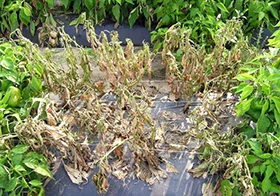
.jpg) From Michigan State University Extension:
From Michigan State University Extension:
Photo: Blighting and death of peppers caused by P. capsici. Courtesy of Michigan State University Extension.
The Great Lakes region produces a wide range of vegetables that are vulnerable to root, crown and fruit rot caused by the soilborne fungus Phytophthora capsici. This pathogen can infect both fresh market and processing plantings of all the cucurbit crops, eggplants, peppers and tomatoes. This pathogen has two mating types that can come together to form long-term survival spores (oospores). These oospores may survive in soil up to 10 years or more without a susceptible crop, and both mating types that are needed for oospore production have been found in every sampled field in the region.
Rainfall and warm soil temperatures favor Phytophthora. The most effective control measure that growers currently have available is to avoid planting in infested soil and limit the spread of the pathogen to clean fields. This pathogen can be found in irrigation ponds and other surface water sources which have likely led to the high number of infested acres across the major vegetable production areas of our state.
Properly constructed raised plant beds – 8 inches in height – can be helpful in limiting root and crown rot as they keep vulnerable plants from saturated soil conditions. However, raised plant beds are most readily suited for use in fresh market production. Planting tolerant pepper cultivars is an important component of a Phytophthora management strategy. Tolerant varieties can reduce costs associated with fungicide usage, transplant losses, and postharvest losses. For P. capsici, which can infect root, fruit and foliage of peppers, resistance is needed for all three symptoms (Photo 1). Fruit rot is less common for Michigan growers than root rot. Unfortunately, some fields in Michigan harbor Phytophthora isolates that are so virulent that they can overcome some of the currently available tolerant pepper isolates.
Foliar applications of preventive fungicides have been recommended with an emphasis on good coverage of the plant crown and lower stem. Michigan studies and grower reports indicated that better control was needed. Michigan State University Extension’s recommendations currently focus on the approach of applying fungicides directly to the soil either by transplant drenches or drip irrigation. These soil applications appear to be more effective in protecting the plants from crown and root rot than foliar applications alone. Unfortunately, not all fungicides include applications to the soil on their label. For example, Presidio, Ridomil Gold or Zampro can be applied via drip applications according to their labels.
Latest from Produce Grower
- CEA HERB Part 1: Best practices for producing culinary herbs in controlled environments
- Jim Jones, FDA deputy commissioner for human foods, resigns over mass staff cuts
- Orbia's precision agriculture business Netafim releases Hybrid Dripline system
- Ledgnd opens second location, adds new functionalities to MyLedgnd software portal
- This fast and agile robotic insect could someday aid in mechanical pollination
- Hydrofarm joins GLASE as premium industry member
- Food safety leaders unite for LinkedIn live event on effective communication in crisis
- UGA professor Erich Schoeller to discuss IPM best practices for CEA at Indoor Ag-Con 2025





